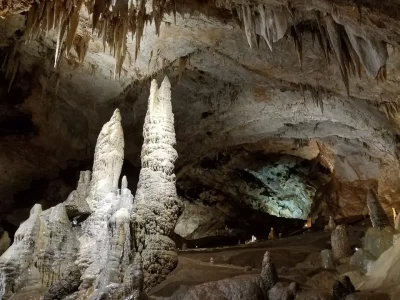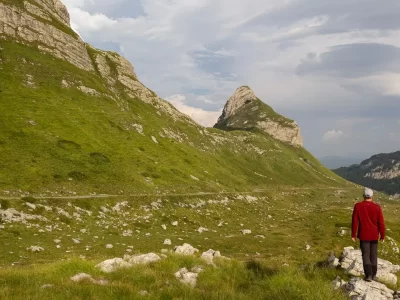Seen from a distance, the Ostrog monastery looks as if a dab of white paint landed high up on the face of Ostroška Greda, a big rock with a nearly vertical cliff. I kept thinking “How did they build that up there?”.
As we drove closer and the shape of the building became more defined, I then thought “How did they start building that up there, in the 17th century!?”.
It’s like the monastery was inserted in the cliff after carving the face of the rock. But more than being an architectural wonder, Ostrog Monastery is considered a sacred place.
It’s the most significant pilgrimage site in Montenegro and the most visited in the Balkans.
Disclosure: This post contains some affiliate links. If you make a purchase through those links I will earn a commission at no additional cost to you (zero, nada). To check the full disclaimer, click here.
This is how to visit the Ostrog Monastery
Table of Contents
Why Is Ostrog Monastery Important?
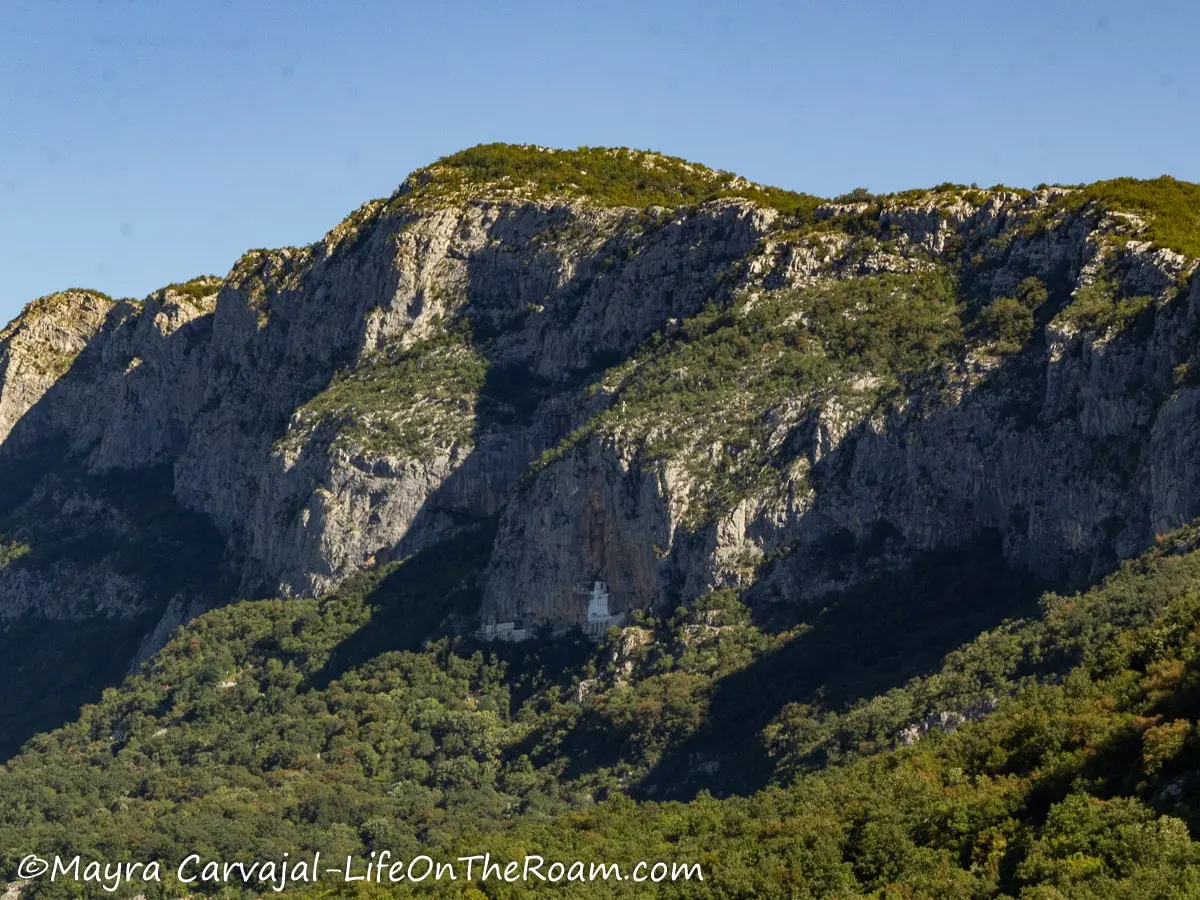
For many, the Ostrog monastery is a tourist attraction: an architectural marvel with fabulous views, beautiful mosaics, and vivid frescoes.
And for many, Ostrog is a place of worship for the Serbian Orthodox Church where every year more than 100,000 visitors of Catholic, Orthodox, and Muslim faith come for praise and healing.
This holy place is dedicated to Saint Basil of Ostrog (Sveti Vasilije Ostroški), a monk and the Metropolitan Bishop of Herzegovina who lived an exemplary life of service and compassion, and who was a defender of the Orthodox church in the 17th century.
To escape pressure from the pope -who wanted to impose the Catholic faith in the country- and prosecution from the Turks, he moved inside a cave above the Upper Monastery at Ostrog. Before him, in the early 17th century, Saint Isaiah hid here to escape the Ottoman invasions, living an ascetic life.
From this cliff, Saint Basil fulfilled his role as Bishop while leading and actively participating in the remodeling and expansion of the monastery until his death in 1671. Occasionally, he would go down to villages to spend time with his people.
The Miracles
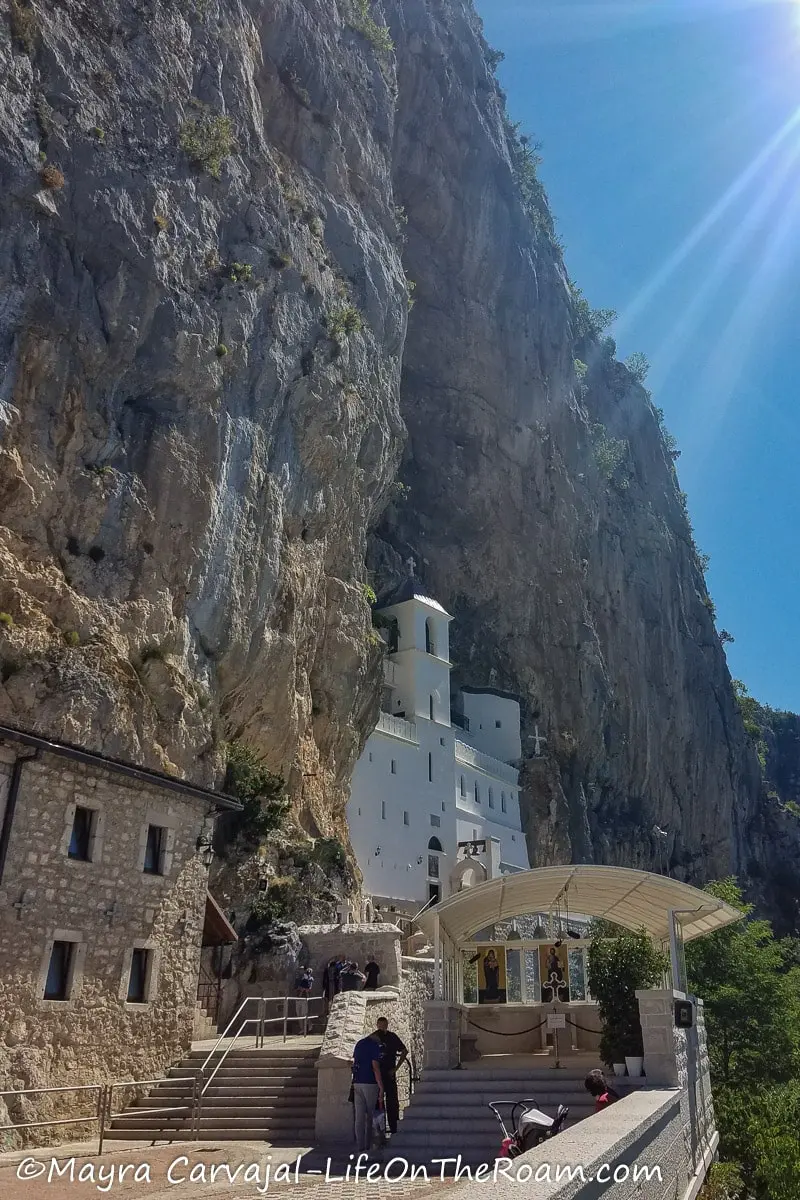
Several miracles have been attributed to Saint Basil over the course of his life. However, the most significant events happened after his death.
According to the legend, an abbot of the Župa Monastery had several dreams where Saint Basil asked him to go to Ostrog and open his tomb. When he finally got there and asked the monks to open the tomb they were surprised to find that the body had not deteriorated and smelled like basil. This is a sign of holiness in the Orthodox Church which prompted his canonization.
They moved his relics to the Church of the Presentation, where people rushed to pray for physical and spiritual healing, with many claiming to have experienced miracles.
Over the years, millions of pilgrims from around the world have made their journey to the monastery to find solace.
Not a believer? You can still visit Ostrog and enjoy the beautiful site while showing respect for the faith and traditions.
The Upper Monastery (Gornji Manastir)
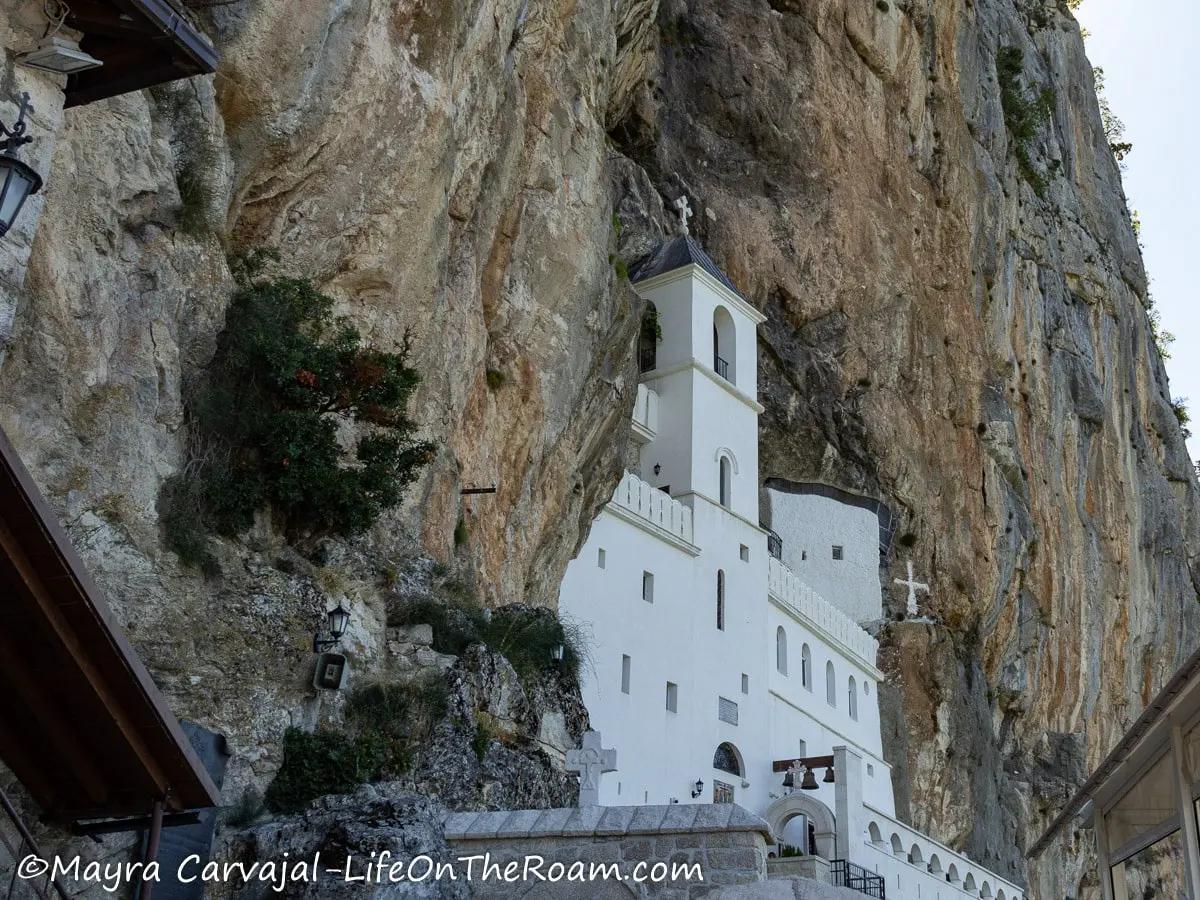
The upper monastery is composed of the two big buildings you see high up in the hill. It’s the main prayer site where you’ll find two cave churches, a candle room, a gift shop, a few monastic residences, and an ample courtyard. And a fantastic view.
Even though the monastery expanded its square footage under the leadership of Saint Basil in the 17th century, the building standing here is from 1926.
In the early 20th century a big fire destroyed pretty much everything, except for the two churches inside the small caves.
If you visit during the high season (May, July, August) you’ll have to line up to enter the Church of the Presentation. It may take half an hour or longer.
We visited off season on a weekday so there were only a handful of people around and we only had to wait a couple of minutes. We spent about a little bit more than an hour at the upper monastery.
Admission is free and donations are welcome.
The Church of the Presentation
After you walk past the open courtyard and take the stairs towards the big white building you’ll find the church dedicated to the Presentation of Virgin Mary.
The church, set up inside a cave in the 17th century, is the most important spot in the monastery from a religious and cultural point of view. This is where you’ll find the relics of Saint Basil -which are said to have healing powers- and where you’ll see the original frescoes, painted directly on the stone with vivid blue and green tones, and red and yellow accents.
When entering the small cave, step aside and take some time to admire the frescoes and take in the solemnity of the moment.
After you approach the objects displayed, you’ll be escorted to the exit if there’s people behind you.
Following the tradition, you’ll see people kissing everything: the cross, Saint Basil’s portrait, the books placed in the lecterns. You don’t have to do that, just show respect (above all this is a holy site) and keep your phone in your pocket. No photography is allowed inside the church.
People bring a donation in the form of blankets and consumables for the monks, or cash that is distributed amongst the poor. If you wish to make a contribution, you’ll find donation boxes where you can deposit cash.
The Church of the Holy Cross
After visiting the Church of the Presentation we took the stairs to the top floor of the upper monastery where we found the Church of the Holy Cross. Allegedly, there’s a piece of the cross here.
This church, usually less busy than the one holding the relics of Saint Basil, is also set up in a cave and it’s also decorated with beautiful frescoes. No pictures allowed here either.
The Mosaics
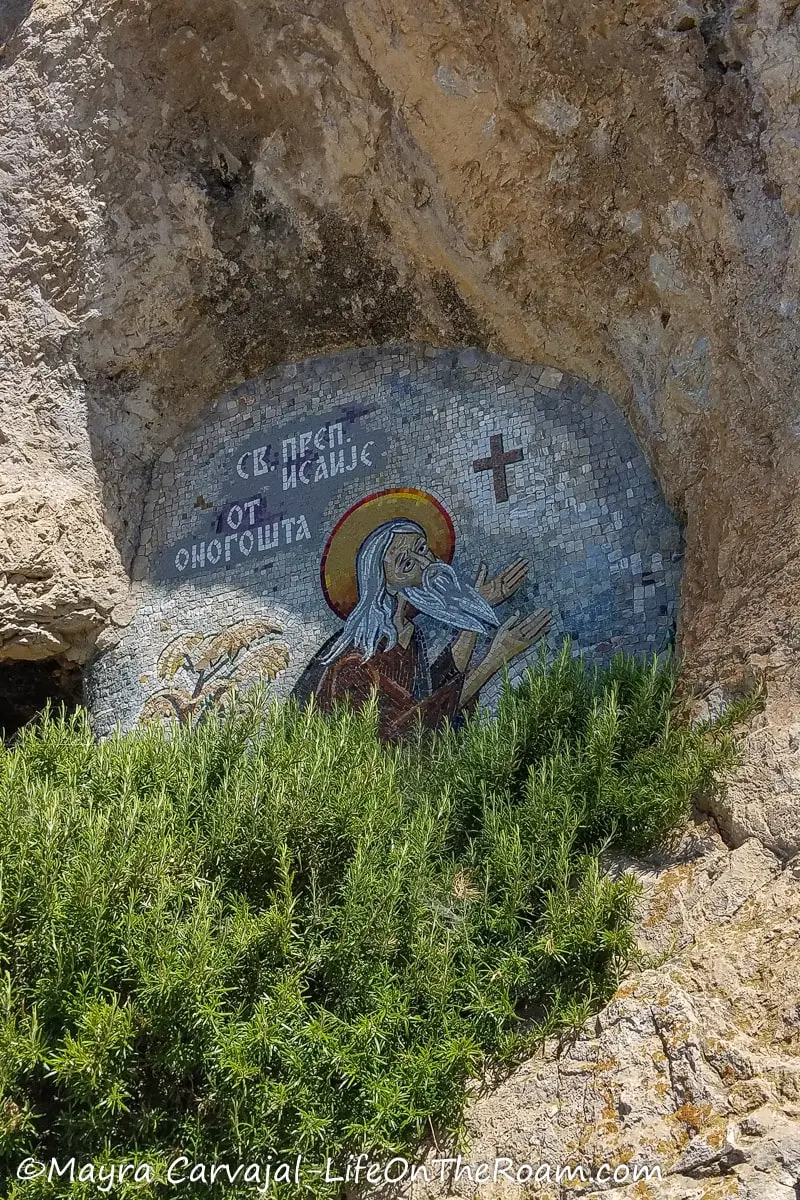
As you walk around the monastery you’ll see many mosaics depicting religious figures and scenes.
The first ones are under the entrance arch of the upper monastery and above the water fountains.
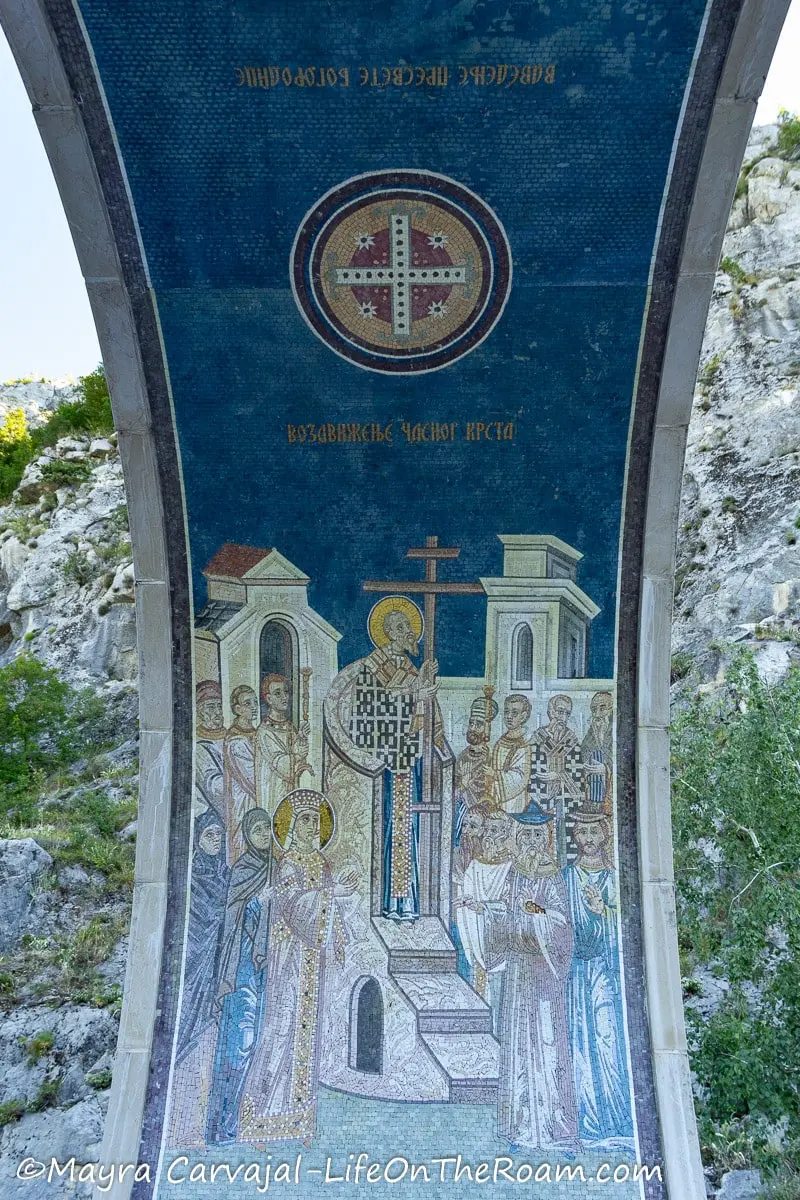
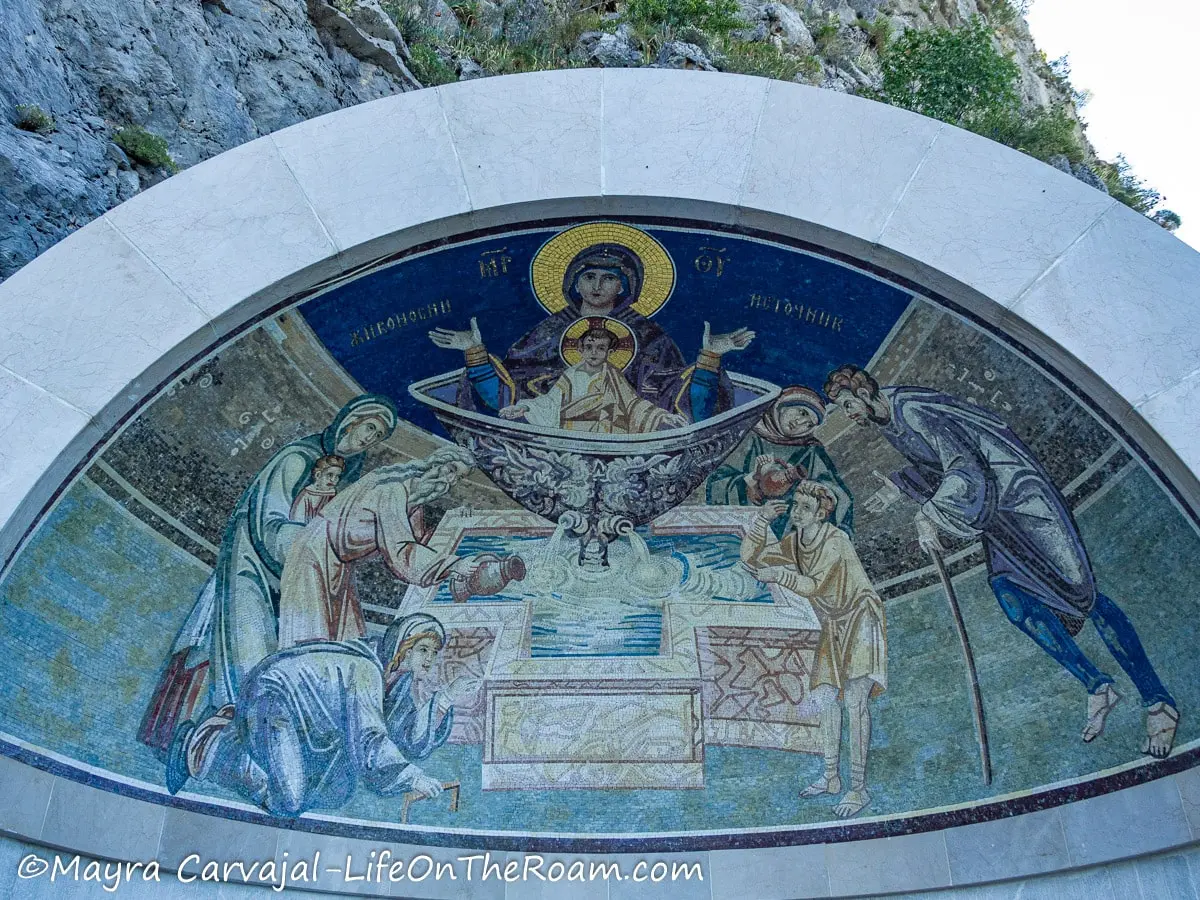

You’ll see them later in the upper arches of the building housing the shop and the candle room.
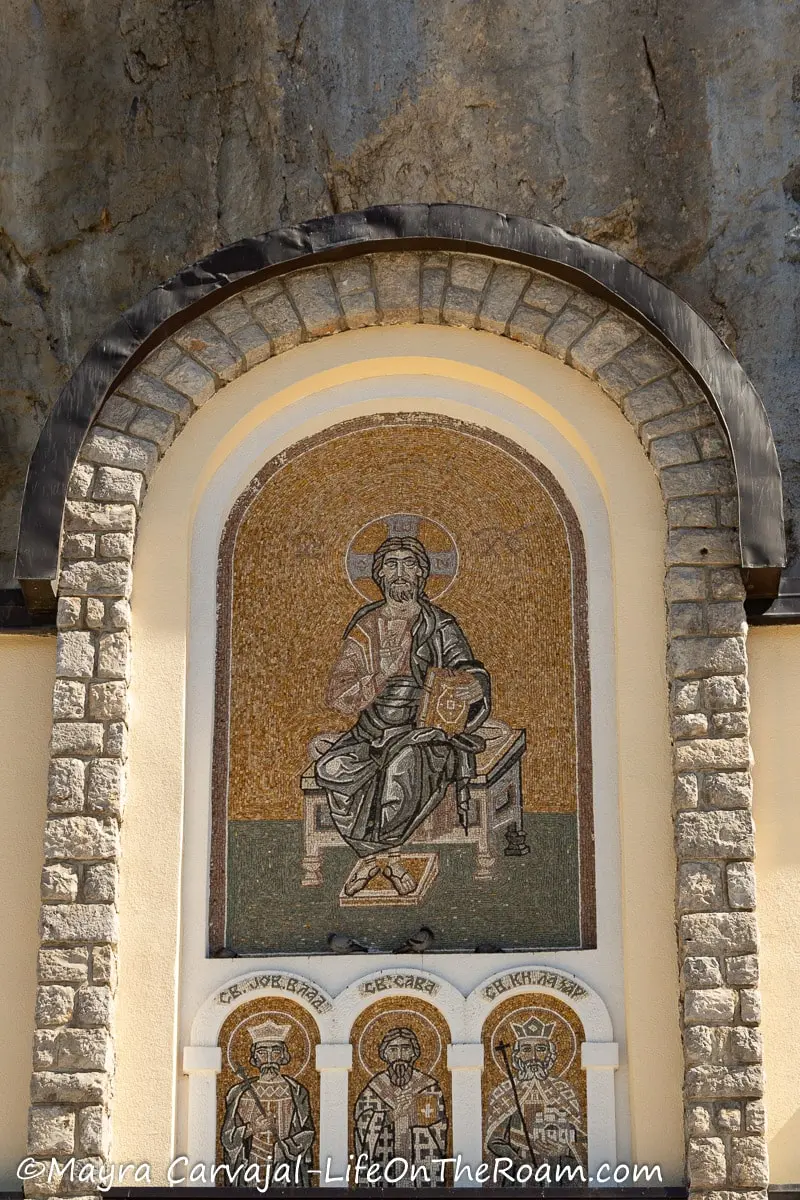
There are more mosaics inside the white building with the two cave churches. You’ll find several (big ones) on the upper floor, which looks like a big wide cave. The mosaics are applied directly on the cliff, with a few ones adorning the staircases.
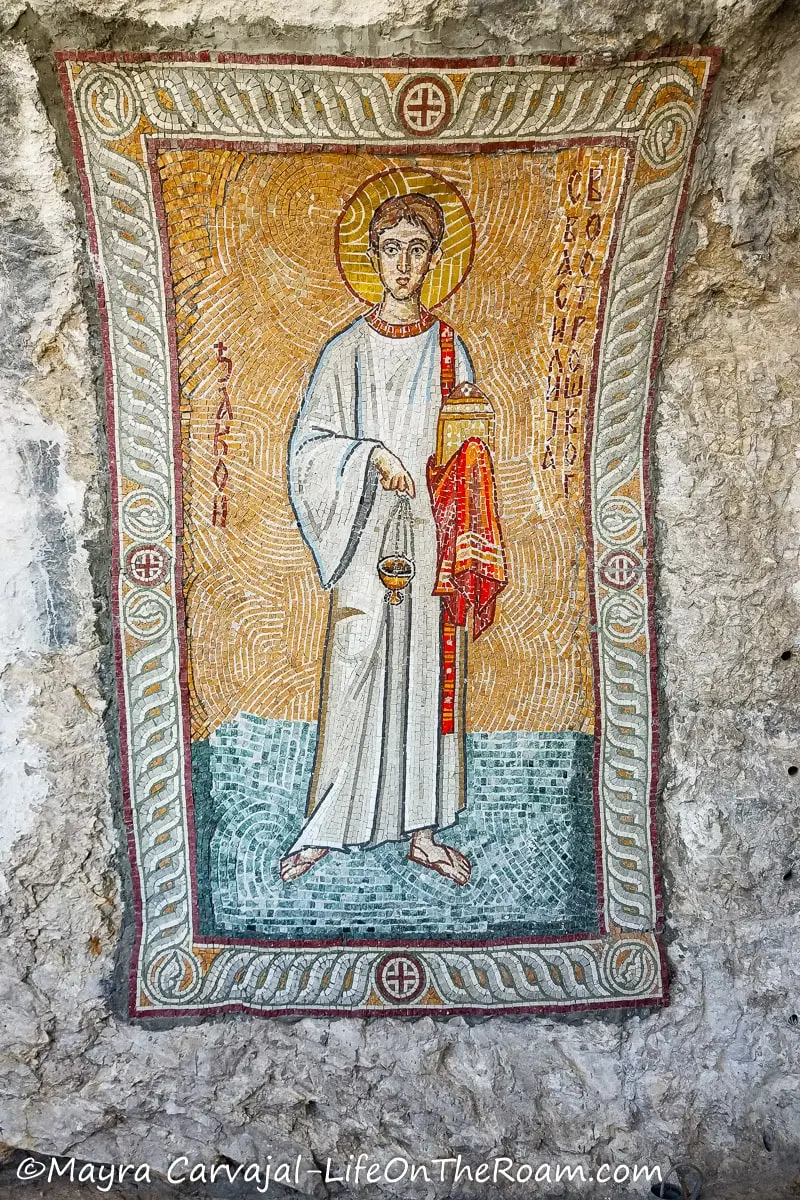
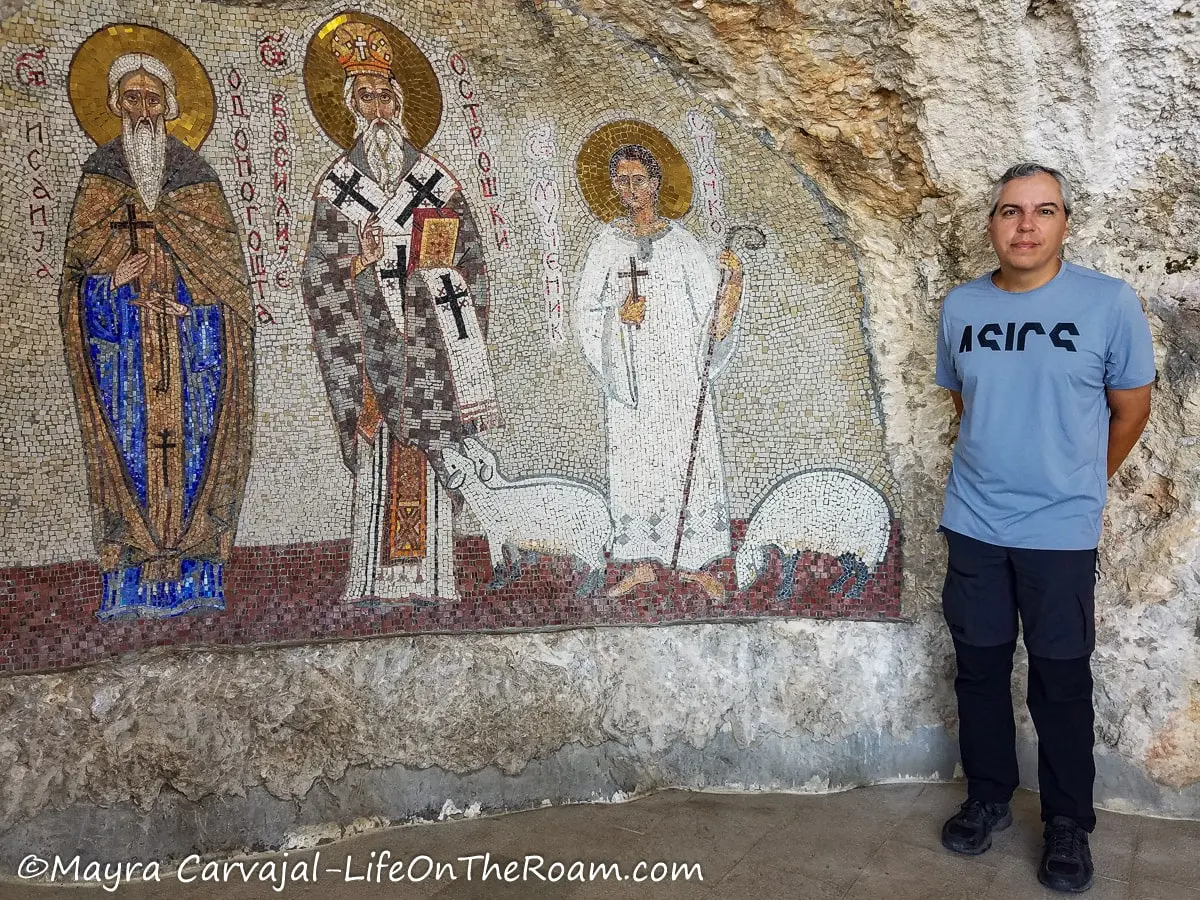
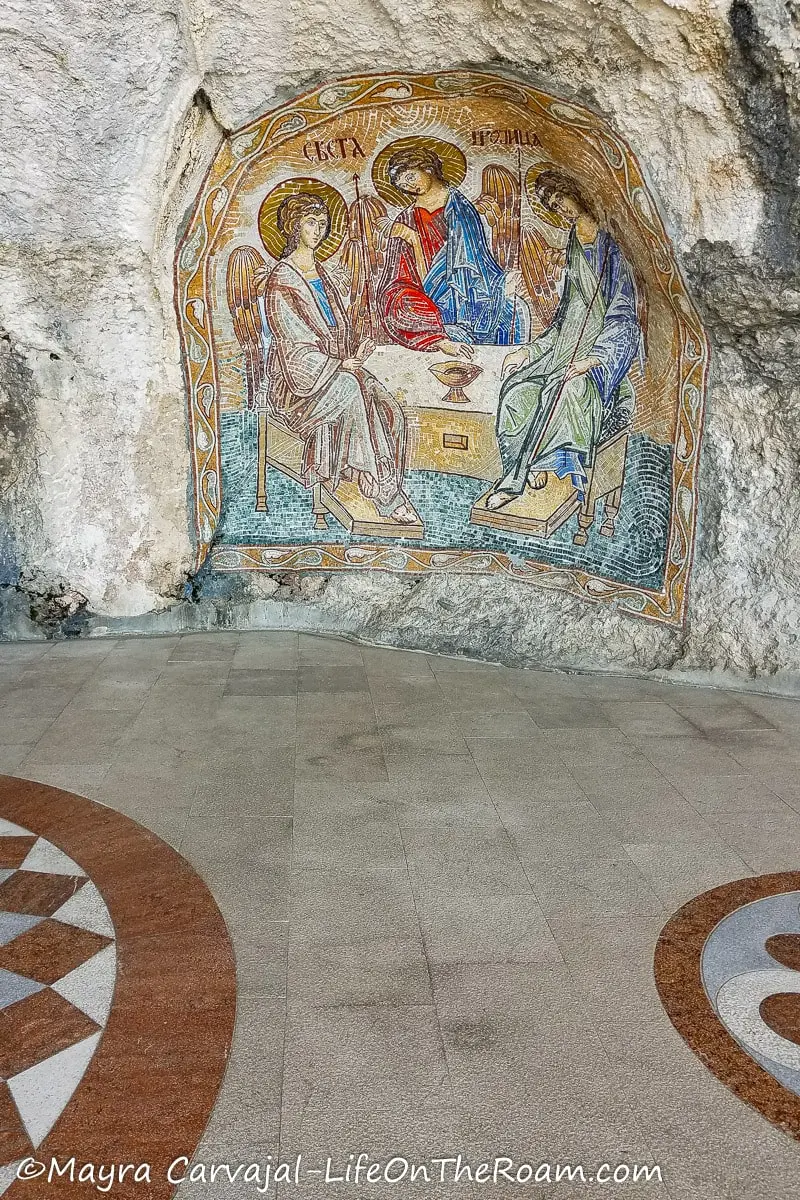
The View

Thanks to its position high up in the cliff, at 841 metres (2,759 ft.) you’ll be gifted with an incredible view of the valley below and the mountains across.
The Gift Shop and the Candle Room
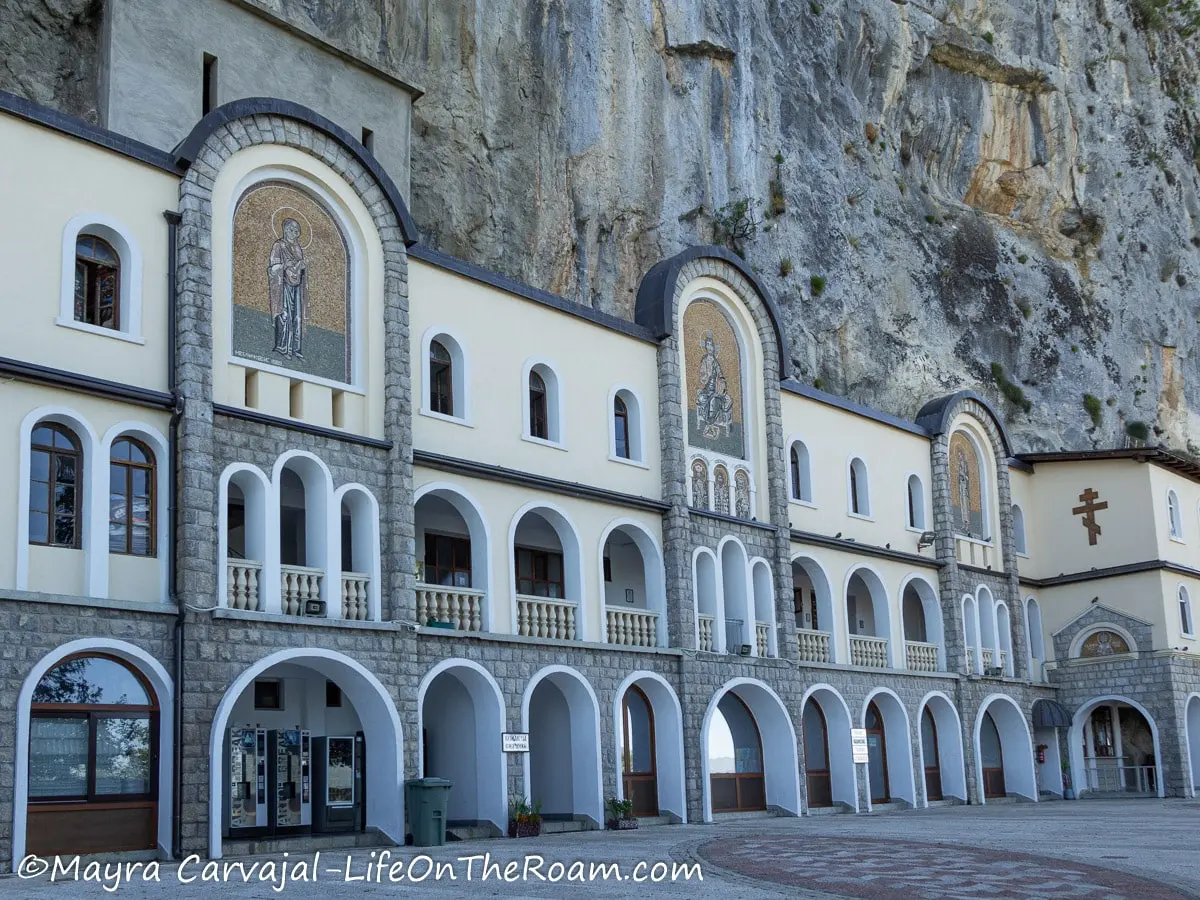
Right next to the courtyard you can visit a gift shop selling not only religious mementos, but a whole variety of goods like honey, herbs, wine, jellies, tea, vinagre, olive oil, creams, soaps, and much more.
To the right of the store is the candle room. You can buy a few candles to follow the tradition of lighting candles and pray for the living and the dead.
Other sections of the upper monastery include residences for the monks.
The Lower Monastery (Donji Manastir)
The lower monastery is 3 kilometres down the steep hill and it’s home to the Church of the Holy Trinity, built in 1824 and decorated with pretty murals. Here are located more residences for the monks.
What Do You Wear to Ostrog Monastery?
Wear something that covers your shoulders and your knees. You’ll see some women covering their head, but it’s not required.
Tours to Ostrog Monastery
Want to skip the drive? Check out these highly rated tours.
Ostrog, Niagara, and Lake Skadar: this private tour combines a stop at the Niagara waterfalls near Podgorica with a visit to the Ostrog Monastery, and a trip to Skadar Lake National Park where you have the option of taking a boat tour.
Book this tour, with a 4.8/5 rating based on more than 20 reviews.
Ostrog and Durmitor: stop for photo ops at Perast before ascending to Durmitor National Park where you can walk on the Tara Bridge and hike around Black Lake before visiting Ostrog at sunset. Pick up available from Kotor, Budva, Tivat, or Herceg Novi.
Book this full day tour, with a 4.8/5 rating based on more than 1,290 reviews.
Can You Sleep at Ostrog Monastery?
Yes, you can. There are male and female rooms available at the lower monastery for €5 per night, with 8-10 beds. There are also bunk beds in the upper monastery in a large hall.
Or you can sleep on the floor outside in the courtyard. You’ll be given a thin mat and a blanket.
Don’t expect a hotel experience, though. There’s no food and the wake up call is at 5:30AM.
Where to Stay Near Ostrog Monastery
Hotel Sokoline: this modern 4-star hotel has a terrace with fantastic views. All units have a private bathroom, flat screen TV, and breakfast is included. Some units have a seating area.
Enjoy the view from Sokoline, with a rating of 9.6/10 based on more than 820 reviews.
Old House Kontic: if you prefer to stay in an apartment, this option offers large units with flat screen TV, a desk, seating area, a private bathroom, and a kitchen. Breakfast available for an extra fee.
Book a room at Kontic, with a rating of 9.8/10 based on more than 425 reviews.
How to Get to Ostrog Monastery
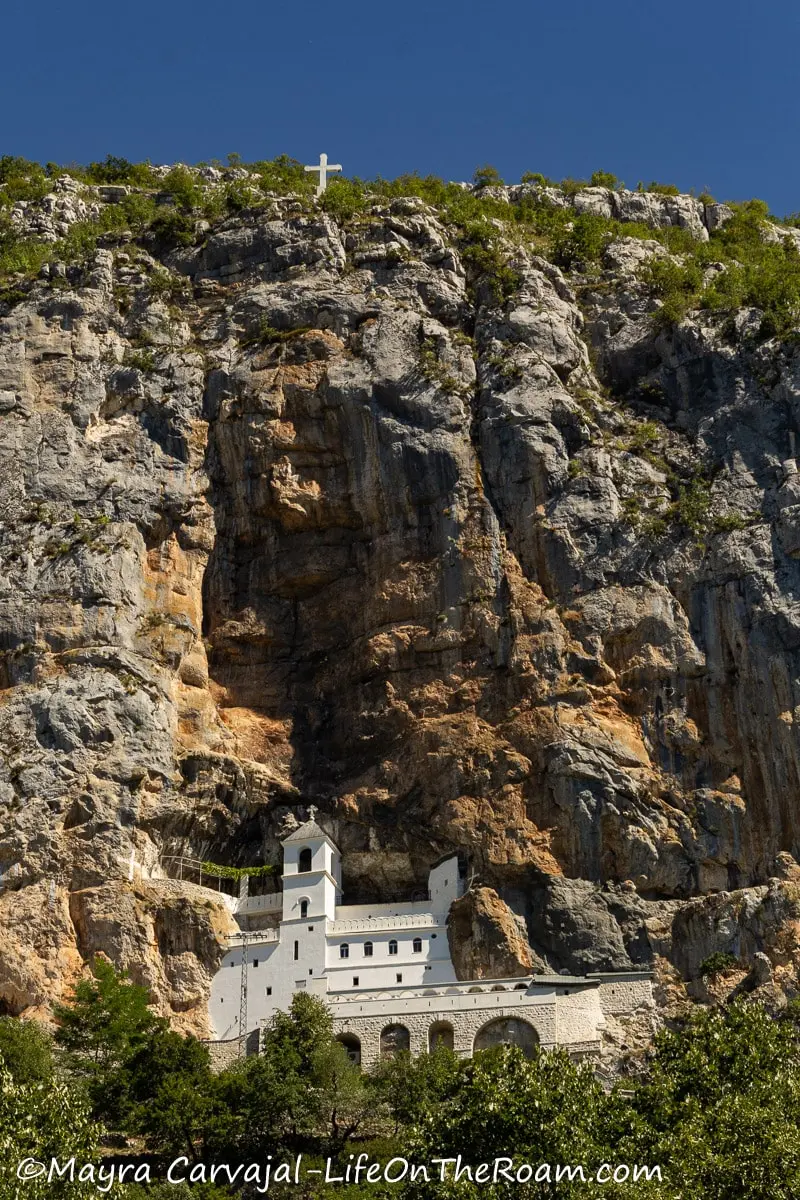
By car
It’s the easiest way to reach Ostrog on your own, as the public transit option drops you near the monastery but you have to hike uphill for a couple of hours. We drove from Budva, taking road M2.3 to Podgorica (it’s relatively new) and then the M18 highway towards Nikšić turning right at the Danilovgrad exit, which is the newer road (don’t take the old road unless you want a white-nuckle ride).
You’ll find the directions on Google Maps and there are signs on the road, some in Cyrillic, reading OCTPOГ.
The road is in good condition, but as you approach the monastery it’s an uphill trip with hairpin turns.
Driving there? Find the best rates with Rental Cars
Parking
There are several parking lots available.
The first one you’ll encounter is in the lower monastery. Then another small one a couple of switchbacks later, and a larger one closer to the upper monastery.
We visited well off-season on a weekday so we were able to park right at the upper monastery.
Where you’ll end up will depend on what season you visit. If you park in any of the lots located in the lower levels there’s a shaded path in the forest with stone stairs that will take you to the upper monastery.
It takes most people between 45 minutes to an hour to climb the stairs from the lower to the upper monastery.
If you take the stairs you may see people walking barefoot, as part of their pilgrimage journey.
By Train (from Podgorica)
This is a rather long journey, especially if you visit during the high season when you have to add waiting time to enter the church. Take the 8AM train so you have enough time.
You’ll board the train at Podgorica station and get off at the Ostrog station. The trip is 46 minutes long.
From there, step on the trail following the signs (use your phone as a backup). It’s an uphill hike that takes about 1.5 hours to the lower monastery, and another 45-60 minutes to the upper.
Bring water as there’s nothing at the train station.
Plan for a 2-hour visit (if there are no lines). It’s another 2 hours to go back to the station so it’s pretty much a whole day affair.
Aim to be on time for the 5:17PM train as you may not want to be at the station at night. Most train stations in Montenegro are unmanned and look like ghost towns.
The train fare is €1.80, each way. Check the train schedule for any changes at https://zpcg.me/
Note: if you visit during the high season you may find a taxi at the station to take you up there, but don’t count on it.
Best Time to Visit and Opening Hours
The time of the year you visit will dictate how long you will be standing in line to enter the Church of the Presentation.
On May 12th, pilgrims commemorate the death of Saint Basil, so you can expect the site to be packed to the max. July and August are also extremely busy, with long lines.
A visit during the shoulder season on a weekday will help avoid the crowds.
Ostrog monastery is open everyday, but hours vary. It normally opens at 6AM and closes anytime between 4PM (October to April) and 8PM (May to September).
Ostrog Monastery is an important site from a religious, historical and architectural point of view. A visit to this centre, blessed with stunning surroundings, will surely lift your spirit.
Want to know about another site in Montenegro with awesome views? Plan a trip to Lovćen National Park.
YOU MAY ALSO WANT TO READ
BOOKING FLIGHTS AND ACCOMMODATIONS
Book your flight without losing your shirt
We check Momondo to find great deals to book our flights. Also, check Great Escape: it combines the listings from Expedia, Kiwi, Kayak, (and Skyscanner on the premium service) to find the best airfares.
To find a place to stay for less
Booking.com: this site combines everything under the sun. You’ll find hotels, apartments, B&B, hostels, rooms, etc., with all sort of filters to make your search a breeze.
Hotwire: the first site I check when we plan to stay at a hotel for a few nights. You can save anything from 20% to 60%. Use the search filter to find what you want and you’ll end up with three listings that match your criteria. You’ll know which one you’ll get after you book. If you can handle a little bit of uncertainty you can score big savings.
House Sitting: you take care of people’s pets and house for free while staying for free. It’s the closest thing to experiencing a place “like a local”. But it comes with responsibilities… Are you an animal lover? It may become your new way to travel.
To get travel insurance
SafetyWing: travel medical insurance that gives us peace of mind knowing that we’re covered in case of emergency. It’s convenient, affordable, and suitable for digital nomads who spend a long time outside their home country.
Check the full list of travel resources on my Resource Page for more options and savings

